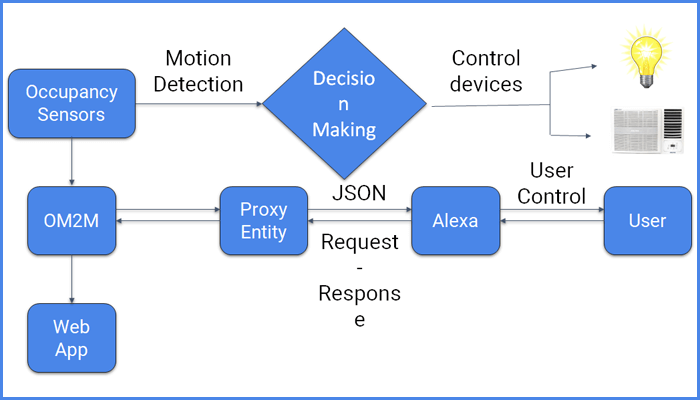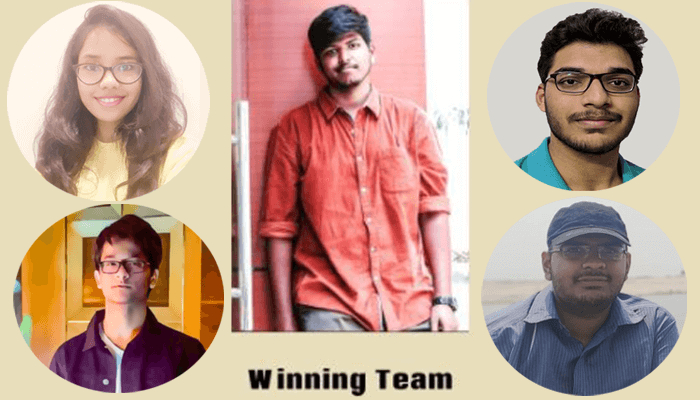An international oneM2M hackathon organised by Korea Electronics Technology Institute to commemorate its 30th anniversary saw IIITH walk away with the Best User Application award.
IoT is synonymous with smart solutions or devices as they are an integrated bundle of connected sensors, used to collect and analyse data. But with IoT becoming all-pervasive, it was increasingly imperative to have a common service layer that would be efficient in the deployment of all the IoT devices. Enter the oneM2M initiative. Kickstarted by 8 organisations that got together with the idea of having a uniform standard, it cuts across industry verticals allowing any IoT application to discover and interact with any IoT device.
In order to promote awareness about oneM2M itself and to create functioning solutions at the end of the event, Korea Electronics Technology Institute in collaboration with organisations such as the European Telecommunications Standards Institute (ETSI), the International Digital Cooperation project (InDiCo) and others, conducted a global hackathon last month. Two teams from IIITH participated in the event with one of them bagging the Best User Application Award that carries a monetary reward of 1 M KRW (64,000 INR)
The IIITH Teams
Both the IIITH teams were from the Smart City Living Lab that has been set up on IIITH campus with support from MEiTY (Government of India), the Smart City Mission and Telangana State government in collaboration with European Business and Technology Centre (EBTC) and its associate the Amsterdam Innovation Arena. The challenge required all participating teams to “build an IoT solution that can help citizens solve major environmental and societal issues” with the help of any of the oneM2M standards. IIITH’s Living Lab is no stranger to this ask, having been set up to assist startups and researchers develop smart solutions for smart cities in areas of energy efficiency, air and water quality monitoring, climate control, smart lamp posts and so on.
Energy-Efficient Solution
The winning team led by SVSLN Surya Suhas Vaddhiparthy with Usha Sai Goparaju, C.G.S. Ganesh, Aakash Dantre and Ruthwik Muppala under the guidance of Dr. Deepak Gangadharan and Anuradha Vattem, Lead Architect of the Living Lab, built a solution to optimise indoor energy consumption. Speaking of why they chose this particular problem statement, the team remarked that with the consequences of climate change being felt every day, any contribution to a reduction in the global carbon footprint is significant. According to them, the problem with existing energy optimisation solutions is that they are locked into an ecosystem with little to zero inter-compatibility and interoperability. Plus, the users are typically restricted to the data shared by the corresponding apps and APIs while being dependent on the manufacturer for long-term support. All of this adds up to the cost. The team proposed a seamless data exchange model compatible with any sensor and controller. Each participating team was allocated a budget for purchasing hardware like sensors, actuators and microcontrollers for building their solutions. Suhas and his teammates used it to procure off-the-shelf passive infrared (PIR) sensors for automating conventional lighting and air conditioning devices based on motion sensing. However, they added a manual override to the system too by integrating it with Alexa. “Not only are the PIR sensors notorious for false detections, there may arise instances where one requires the air conditioning to kick in before stepping into a room,” says Dr. Vattem, explaining the need for an override. The team also developed a dashboard which served as a master control and a visual one-stop shop for displaying energy usage by frequency, (in days, weeks or months) and by each device. “We used Eclipse OM2M for this project which is an open source implementation of the oneM2M standard,” says Suhas, adding that oneM2M features such as having an access control policy for security and IPE development for integration with Alexa and other devices were incorporated into the design.

The Smart Campus Solution
The other team comprising of Shubham Mante, Ihita Gangavarapu, Ayu Parmar, Aman Singh and Prabhav Bansal under the guidance of Dr. Sachin Chaudhari submitted a solution for a smart campus IoT system. Their solution consisted of an air quality alert system and automated room ventilation to minimise risk of Covid-19. Deployable in specific areas of a campus like an Academic block, the dining hall and a quarantine and isolation ward, the system had subscription features of oneM2M that would send notifications whenever the fire alarm system was activated or whenever windows were automatically opened up. In addition to this, they also built a dashboard to help visualise data which was maintained securely.
Referring to the barely year-old team that has joined at the Living Lab, Dr. Vattem is all praise for them when she says, “They worked hard and picked up really well. By virtue of their diverse capabilities, they were able to team up together and make a wonderful solution that made IIITH’s presence felt. The win proves our capabilities and shows that we stand a good chance at the international level.”

